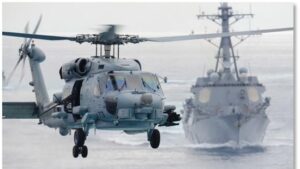
The Navy’s Future Vertical Lift (Maritime Strike) is being developed to perform unique maritime missions and operating primarily from Surface Combatants (DDGs, FFGs, LCS). (U.S. Navy photo)
The Navy’s Future Vertical Lift (Maritime Strike) (FVL (MS)) program recently completed its Analysis of Alternatives (AoA), culminating in a Deputy Chief of Naval Operations (DCNO) for Warfighting Requirements and Capabilities (N9) “Gate 2” Resources and Requirements Review Board (R3B).
The board unanimously endorsed the results of the AoA and directed the program to proceed with the development of a Capabilities Development Document (CDD) and a Concept of Operations (CONOPS).
The Navy’s legacy helicopter fleet of MH-60R and MH-60S Seahawks will begin to reach the end of their service lives in the late 2030’s following Service Life Extensions for both aircraft. FVL (MS) provides the Navy with the opportunity to transition the existing legacy fleet to a more capable platform required to operate in a Distributed Maritime Operations concept.
Director, Air Warfare Division, N98, Office of the Chief of Naval Operations, Rear Admiral Buzz Donnelly said, “FVL (MS) will be the most widely distributed aviation platform in the Navy embarking on all surface combatants from future FFG to aircraft carriers and will contribute to more primary mission areas than any other aviation platform in the Navy.”
FVL (MS) is envisioned as a crewed and uncrewed Family of Systems (FoS) that will perform the missions that legacy helicopters perform today, but with greater ranges, endurance, and modularity to capitalize on emerging technologies. The FoS will be developed under the same Program Executive Office (PEO) to maximize interoperability, including crewed – uncrewed teaming. The FVL (MS) FoS will be more capable, survivable, reliable, and sustainable.
The Navy’s Future Vertical Lift (Maritime Strike) is being developed to perform unique maritime missions and operating primarily from Surface Combatants (DDGs, FFGs, LCS); FVL (MS) will leverage many Army FVL and Marine Corps vertical take-off and landing (VTOL) FoS efforts. The program is informed by the Army and Marine Corps advances in improved engine design, digital backbone, Modular Open Systems Architecture (MOSA), advanced rotor blades, materials and launched effects.
While we work towards a materiel solution and work toward an initial operational capability (IOC) in the early 2040s, OPNAV N98 and Naval Air Systems Command will hold an Industry Day in 2024 to relay requirements for FVL (MS) capabilities and to share concept of employment (CONEMPS) details.


